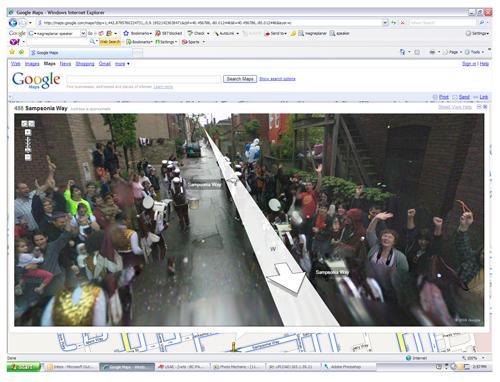Artists stage street scenes to lurk in Google maps

The Associated Press
November 13, 2008
PITTSBURGH – Anyone using Google’s Street View map feature to scan one downtown Pittsburgh street is bound to do a double take.
Two 17th century swordsmen doing battle? An escape from a building using knotted sheets? A laser zapping a Steelers fan and a Cleveland Browns fan, rendering them love-struck and about to embrace?
That can’t be real.
But it is. And it isn’t.
Google really did capture those scenes when it sent a car equipped with cameras down Pittsburgh’s Sampsonia Way in May to take photographs for its online maps. But these images and most of the other scenes caught on Sampsonia were staged by artists Ben Kinsley and Robin Hewlett. The two set out to explore the boundaries of the real and virtual worlds after Pittsburgh became included in Street View.
Get The Daily Illini in your inbox!
The Google feature provides panoramic street-level photographs online so users can get a feel for wherever they might be heading – a virtual reconnaissance mission of sorts. Is there metered parking? A place to eat? What’s the neighborhood like?
Like many first-time Street View users, Kinsley and Hewlett, then roommates, typed in their address and found their house. Kinsley and Hewlett soon found themselves discussing surveillance and virtual reality, and began considering how they might explore those issues and Street View through art.
“But instead of dwelling on the darker undertones of these issues, we began to think about ways of playing with the system,” Kinsley said in an e-mail interview from Iceland, where he is participating in an artist residency. The “Street With a View” project was his master of fine arts thesis project at Carnegie Mellon University.
“We were interested in interjecting something staged, something fictional, into Street View and playing with – and subtly questioning – the notion of reality in something that we perceive as a factual representation of our world,” said Kinsley, 26.
This idea draws some of its inspiration from the way that Google Street View has preserved many random, mundane moments in time as its cameras have swept through cities capturing images. In one city, a woman can be seen leaning over in the seat of pickup truck with its door open, inadvertently flashing her thong underwear. Elsewhere a man is climbing a building, apparently breaking in. Another photo in Street View finds a man passed out on the ground.
By going a step further and artificially creating scenes, Kinsley and Hewlett’s project also amounted to a physical-world analog for the “Easter eggs” that video game designers hide for advanced players to stumble upon. Street View has a video game-like quality that lets users navigate through a street, and Hewlett said she considers the scenes she and Kinsley created as a sort of virtual reward for online explorers.
“We attempted a balance between the subtle and the spectacular,” said Hewlett, 28. “Seen individually, any one of these things may not raise your curiosity that much … but coupled together, you may start to question a little more.”
Google – whose own employees posed outside the company’s headquarters in Mountain View, Calif., as its Street View vehicle rolled by – joined in the fun in Pittsburgh after Kinsley and Hewlett contacted the company. Google sent its cameras down Sampsonia on a prearranged day.
“There are all sorts of quirky things that appear organically in Street View, such as a giant rocking chair in Indiana or a wedding in France, which is why this art project was so fascinating,” Google spokeswoman Elaine Filadelfo said. “It spoke to the fact that you never know what you may discover, natural or man-made, while exploring the world via Street View.”
The Mattress Factory, a contemporary art museum on Sampsonia, also helped by connecting the artists with volunteers who staged the scenes. Though the Google car photographed all the scenes in one day, Kinsley said it took months to plan.
The love laser that appears to zap the football fans? It was assembled from clear PVC pipes, dry ice and red LED lights. The “beam” was a red ribbon.






